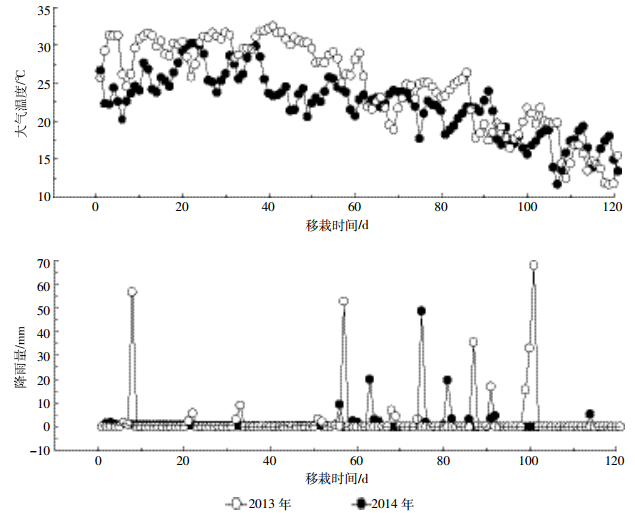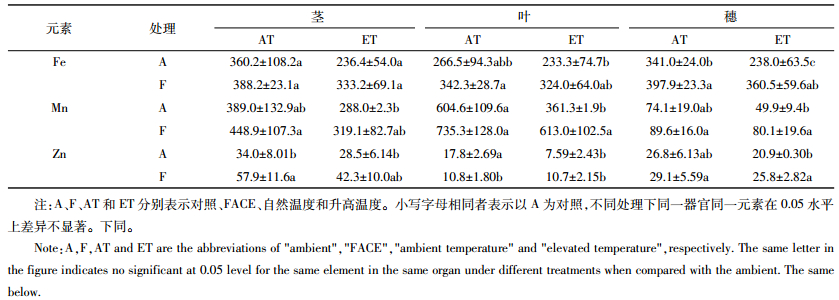文章信息
- 李春华, 曾青, 沙霖楠, 张继双, 朱建国, 刘钢
- LI Chun-hua, ZENG Qing, SHA Lin-nan, ZHANG Ji-shuang, ZHU Jian-guo, LIU Gang
- 大气CO2浓度和温度升高对水稻体内微量元素累积的影响
- Influence of elevated atmospheric CO2 and temperature on microelement accumulation in rice
- 农业环境科学学报, 2017, 36(6): 1021-1026
- Journal of Agro-Environment Science, 2017, 36(6): 1021-1026
- http://dx.doi.org/10.11654/jaes.2016-1636
文章历史
- 收稿日期: 2016-12-20
2. 中国科学院大学, 北京 100080;
3. 南京林业大学生物与环境学院, 南京 210037
2. University of Chinese Academy of Sciences, Beijing 100080, China;
3. Institute of Biology and Environment, Nanjing Forestry University, Nanjing 210037
全球气候变化对生态系统造成的影响已成为公众和科学界关注的焦点,自工业革命以来,大气CO2浓度逐年增加,预计到本世纪中叶CO2浓度将会升高200 μL·L-1 [1]。一方面,CO2浓度增加提高了水稻的光合速率,促进碳水化合物的合成[2-4]与养分元素的吸收[5-6],Guo等[7]发现高浓度CO2会促进Mn和Zn在水稻茎和穗中的累积;另一方面,CO2浓度升高也会导致全球气温的上升,预计到本世纪中叶大气温度将会提高0.3~0.7 ℃[1]。高温(>34 ℃)可抑制水稻的生长,造成其减产[8-9],同时也会影响水稻本身对养分元素的吸收与转运。有研究指出,与高浓度CO2效应相反,高温在植物对养分利用的影响方面呈现一定的负作用。这主要是由于高温限制了水稻生殖阶段的库容[10]。而未来CO2浓度和温度升高是相伴发生的,单因子已不足以代表未来气候的变化趋势,目前关于二者综合效应的报道较少,且多数是在封闭或半封闭式的气室展开的[8, 11-12],对养分元素吸收的研究也主要集中在N方面[13-16],对其他元素尤其是微量元素的研究还未见报道。
水稻是中国乃至亚洲的主要种植作物之一[17],其体内养分元素含量的变化不仅影响元素从土壤到植株的循环,而且会影响水稻籽粒的品质形成。综上所述,我们利用先进的温度-FACE试验平台,研究大气CO2浓度和温度升高对水稻体内微量元素累积的影响,旨在明确未来气候条件下水稻对微量养分的吸收与累积规律。
1 试验材料与方法 1.1 试验地区及平台概况试验地位于江苏省江都市小纪镇马凌村良种场(119°42′0″E,32°35′5″N),该地区年降雨量约1000 mm,年均温度约15 ℃,年均日照时间大于2000 h,年无霜期约220 d。土壤类型为砂姜黑土,土壤质地为砂壤(2~0.02 mm砂粒占57.8%,0.02~0.002 mm粉粒占28.5%,< 0.002 mm粘粒占13.7%)。耕层土壤的基本性质如下:有机碳18.4 g·kg-1,全氮1.45 g·kg-1,全磷0.63 g·kg-1,全钾14.02 g·kg-1,速效磷1.01×10-2 g·kg-1,速效钾7.05×10-2 g·kg-1,阳离子交换量12.8 cmol·kg-1,容重1.16 g·cm-3,pH 7.2。
试验平台设有3个CO2浓度增加(F)圈和3个对照(A)圈,各圈间距大于90 m,以减少CO2释放对其他圈的影响。F圈是一个直径14 m,由8根释放CO2气体管带围成的正八角形,每根管带长5 m,平台运行时通过F圈周围的管道向中心喷射纯CO2气体,同时在F和A圈中西北角处加装热水增温管道区,其中包含7个小区,每个小区长2.7 m,宽0.75 m。试验平台通过热水的能量置换来增加冠层空气温度,利用计算机网络对平台CO2浓度和水稻冠层温度进行监测和控制,根据大气中的CO2浓度、风向、风速、作物冠层高度的CO2浓度和温度自动调节CO2气体的释放速度和方向以及增温管道中热水流速,使水稻主要生育期F圈内CO2浓度保持比大气环境高200 μL·L-1,所有圈内增温区域温度比大气环境温度高1 ℃左右。对照田块没有安装CO2管道和热水增温管道,其环境条件与自然状态一致。
1.2 试验材料与栽培试验于2013和2014年水稻季进行,供试品种为常规粳稻武运粳23(WYJ23)。在2013和2014年分别于5月21日和5月20日进行大田育秧,6月22日和6月21日人工移栽,行距25 cm,株距16.7 cm,24穴·m-2,2株·穴-1。总施氮量为22.5 g·m-2,采用复合肥(有效成分N:P2O5:K2O=15%:15%:15%,下同)和尿素(含氮率46.7%,下同)配合施用,其中基肥占40%,分蘖肥和穗肥各占30%。磷钾肥总施用量均为9 g·m-2,采用复合肥,全作基肥施用。移栽前一天施用基肥,分别于2013年6月28日和7月25日,2014年6月28日和8月1日追施分蘖肥和穗肥。其他田间管理如水分、病虫草害等同大田一致。
1.3 试验设计本试验为裂区设计,设置两个CO2浓度水平:正常大气CO2浓度(A)和高CO2浓度(F,比对照高200 μL·L-1),在每个CO2水平上再设置两个温度水平:自然温度(AT)和增温(ET,比对照高1 ℃),每个水平3个重复。2013年平台布气日期为7月19日至10月10日,时间为6:00—18:00,增温日期为7月20日至10月10日,时间为9:00—18:00。2014年布气和增温日期分别为6月27日至10月25日和6月29日至10月25日,每日处理时间与2013年保持一致。
1.4 样品采集与分析将2013和2014年收获期采集的用于测定水稻生物量的植株样品烘干,磨碎用于植株中养分元素含量的测定,用砻谷机(GLS. JLG-Ⅱ型,中国)对水稻籽粒脱壳,所得糙米进行籽粒元素含量的测定。Fe、Mn和Zn含量采用硝酸-高氯酸消煮,采用电感耦合等离子体原子发射光谱法(ICP-AES)(Optima 8000,PerkinElmer,USA)测定。
1.5 数据处理与分析采用SPSS 16.0软件对结果进行统计分析,用One-way ANOVA方法进行单因素方差分析,方差分析的检验显著性概率临界值为0.05。应用Origin 8.0软件作图。
2 结果与分析 2.1 2013和2014年水稻季田间气象数据2013和2014年7、8月份的平均温度相差3 ℃以上。两年水稻季降雨天数分别为31、52 d,整个水稻季降雨总量分别为325、164 mm(图 1),水稻季平均气温分别增加0.7 ℃和0.9 ℃。

|
| 图 1水稻生长季的日平均大气温度与降雨量 Figure 1The daily average temperature and the rainfall in rice growing season |
与对照相比,2013年高浓度CO2使稻穗中Fe的累积量增加16.7%(P < 0.05),使茎中Zn的累积量增加70.3%(P < 0.01),而使叶中Zn的累积量减少39.3%(P < 0.05)。增温使茎和穗中Fe的累积量分别减少34.4%(P < 0.1)和30.2%(P < 0.05),使叶中Mn和Zn的累积量分别减少40.2%(P < 0.05)和57.3%(P < 0.01)。CO2+温度显著降低了叶中Zn的累积量,降幅达39.8%(P < 0.05),同时有促进叶和穗中Fe与Mn累积的趋势(表 1)。

|
2014年高浓度CO2使稻穗中Fe和Zn的累积量分别提高63.4%(P < 0.01)和30.8%(P < 0.01),有降低叶中Fe、Mn和Zn累积量的趋势。增温降低了茎、叶、穗中Fe和Mn的累积量,但降幅未达显著水平。CO2+温度提高了穗中Fe、Mn和Zn的累积量,其中Zn的增幅高达25.8%(P < 0.05)(表 2)。

|
高浓度CO2使2013年籽粒Fe累积量显著下降47.5%(P < 0.05),使2014年Zn累积量显著增加了43.4%(P < 0.05)。增温降低了籽粒中不同元素的累积量,2013年Fe、Mn和Zn的累积量分别下降42.8%(P < 0.05)、31.5%(P < 0.05)和35.7%(P < 0.05),2014年Fe的累积量显著下降50.1%(P < 0.05),Mn与Zn的累积量亦有下降的趋势。CO2+温度整体降低了籽粒中Fe、Mn和Zn的累积量,其中2013年各元素的降幅大于2014年(图 2)。

|
| A、F、AT和ET分别表示对照、FACE、自然温度和升高温度。小写字母相同者表示在0.05水平上差异不显著 A, F, AT and ET are the abbreviations of"ambient", "FACE", "ambient temperature" and"elevated temperature", respectively. The same letter in the figure indicates no significant at 0.05 level 图 2大气CO2浓度和温度升高下收获期单位面积水稻籽粒中Fe、Mn、Zn的累积量 Figure 2Accumulation of Fe, Mn and Zn in rice grain per unit area at harvest period under elevated CO2 and temperature in 2013 and 2014 |
大气CO2浓度与温度升高会不同程度地影响水稻的生长以及各器官中干物质的合成与累积,同时也会改变水稻对养分元素的吸收与转运。尽管作物对高浓度CO2的响应存在种间特异性,但是研究报道指出高浓度CO2通过增加作物的生物量,提高水分和养分的利用率,提高叶片光合速率和碳水化合物的累积,增加光合产物向根部的分配以及使根系分支增加等形式来改变根系分泌物的组分[18-19],以此来影响作物对养分的吸收与利用[4, 19-20]。
微量元素是植物生长的重要元素,植物对它们的吸收主要是通过根际微环境的改变来实现的。作为氧化还原敏感型元素,Fe、Mn和Zn在低pH值下环境移动性会增强[21],金属元素的还原和移动会促进植物对其的吸收[22]。本研究中,高浓度CO2促进了微量元素在水稻植株尤其是穗中的累积,此结果与前人研究[23]基本一致。高浓度CO2下水稻器官光合速率的提高与分蘖的发生[24],使水稻的生物量显著增加,由于增幅大于元素含量的降低幅度,最终提高了元素在不同器官中的累积量。增温降低了水稻不同器官中微量元素的累积量,并且2013年元素的降幅明显大于2014年。有研究指出当大气温度升高0.8 ℃后,会严重抑制水稻的生长[25],尤其是在北纬10°~35°。高温(>34 ℃)会加速作物的生长,缩短生长期,造成其早熟[26]。在对水稻的研究中发现,高温加速了光合速率的下降,使光合的有效叶面积不断减少,导致水稻地上部和籽粒生物量的减少[27-28]。另有研究发现高温下作物叶片的暗呼吸加强,消耗过多的有机物,最终导致作物的生物量下降[29]。高温下水稻生长受抑,减弱了对养分元素的吸收及转运速率,同时由于生物量的减少,最终降低了器官中元素的累积量。大气CO2浓度和温度同时升高降低了水稻营养器官中微量元素的累积量,但未出现显著差异。这主要是由于高浓度CO2一定程度上缓解了高温对水稻生长的抑制作用,促进了水稻对养分的吸收与转运。因为高温胁迫可由高浓度CO2通过提高光合速率来缓解[30]。单独CO2浓度升高或增温下两年试验结果显示,不同元素累积在水稻植株中的变化幅度有所不同,推测是由于年际间气候条件的差异(图 1)对水稻不同器官生长的影响程度不同。
不同元素在水稻体内的移动性差异较大,最终会导致元素在籽粒中的累积有所不同。本研究不同处理籽粒中Mn与Zn的累积量与产量的变化趋势基本一致。而高浓度CO2导致籽粒中Fe的累积量明显下降,同时与稻穗相比,单位面积籽粒中Fe的累积量大幅减少,2014年通过对水稻颖壳(含枝梗)中元素含量(数据待发表)的测定发现,CO2处理下水稻单位质量颖壳中Fe的含量明显高于籽粒。这说明大量的Fe滞留在颖壳中,只有小部分在籽粒中积累,而Fe的减少会影响水稻籽粒的品质形成。与单独增温相比,大气CO2浓度与温度同时升高有提高籽粒中元素累积量的趋势。这说明增温对籽粒品质的影响也可由高浓度CO2来缓解。
4 结论对植株而言,高浓度CO2增加了稻穗中微量元素的累积量,而增温降低了水稻体内微量元素的累积。CO2+温度也有降低水稻营养器官中微量元素累积的趋势。对籽粒而言,CO2浓度升高降低了籽粒中Fe的累积量,提高了Mn和Zn的累积量。增温明显降低了籽粒中Fe、Mn和Zn的累积量。CO2+温度有降低籽粒中微量元素累积量的趋势,且2013年降幅大于2014年。这说明尽管大气温度存在年际差异,但CO2浓度升高一定程度上仍可缓解未来全球变暖对水稻体内微量元素累积的影响。
| [1] | IPCC(the Intergovernmental Panel on Climate Change). Climate change 2013:The physical science basis[R/OL]. [2016-12-20]. http://www.ipcc.ch/publications_and_data/publications_and_data.shtml. |
| [2] | Ainsworth E A. Rice production in a changing climate:A meta-analysis of responses to elevated carbon dioxide and elevated ozone concentration[J]. Global Change Biology, 2008, 14(7): 1642–1650. DOI:10.1111/j.1365-2486.2008.01594.x |
| [3] | Yang L X, Huang J Y, Yang H J, et al. Seasonal changes in the effects of free-air CO2 enrichment(FACE) on dry matter production and distribution of rice(Oryza sativa L.)[J]. Field Crop Research, 2006, 98(1): 12–19. DOI:10.1016/j.fcr.2005.11.003 |
| [4] | Reddy A R, Rasineni G K, Raghavendra A S. The impact of global elevated CO2 concentration on photosynthesis and plant production[J]. Current Science, 2010, 99(1): 46–57. |
| [5] | Loladze I. Rising atmospheric CO2 and human nutrition:Toward globally imbalanced plant stoichiometry?[J]. Trends in Ecology and Evolution, 2002, 17(10): 457–461. DOI:10.1016/S0169-5347(02)02587-9 |
| [6] | Stafford N. Future crops-the other greenhouse effect[J]. Nature, 2007, 448(7153): 526–528. DOI:10.1038/448526a |
| [7] | Guo J, Zhang M Q, Wang X W, et al. A possible mechanism of mineral responses to elevated atmospheric CO2 in rice grains[J]. Journal of Integrative Agriculture, 2015, 14(1): 50–57. DOI:10.1016/S2095-3119(14)60846-7 |
| [8] | Baker J T, Allen L H Jr, Boote K J. Temperature effects on rice at elevated CO2 concentration[J]. Journal of Experimental Botany, 1992, 43(252): 959–964. |
| [9] | Matsui T, Omasa K. Rice(Oryza sativa L.) cultivars tolerant to high temperature at flowering:Anther characteristics[J]. Annuals of Botany, 2002, 89(6): 683–687. DOI:10.1093/aob/mcf112 |
| [10] | Lin W H, Ziska L H, Namuco O S, et al. The interaction of high temperature and elevated CO2 on photosynthetic acclimation of single leaves of rice in situ[J]. Physiologia Plantarum, 1997, 99(1): 178–184. DOI:10.1111/ppl.1997.99.issue-1 |
| [11] | Ziska L H, Namuco O S, Moya T, et al. Growth and yield responses of field-grown tropical rice to increasing carbon dioxide and air temperature[J]. Agronomy Journal, 1997, 89(1): 45–53. DOI:10.2134/agronj1997.00021962008900010007x |
| [12] | 万运帆, 游松财, 李玉娥, 等. CO2浓度和温度升高对早稻生长及产量的影响[J]. 农业环境科学学报, 2014, 33(9): 1693–1698. WAN Yun-fan, YOU Song-cai, LI Yu-e, et al. Influence of elevated atmospheric CO2 concentration and temperature on growth and yield of early rice[J]. Journal of Agro-Environment Science, 2014, 33(9): 1693–1698. DOI:10.11654/jaes.2014.09.004 |
| [13] | Kim H Y, Lim S S, Kwak J H, et al. Dry matter and nitrogen accumulation and partitioning in rice(Oryza sativa L.) exposed to experimental warming with elevated CO2[J]. Plant and Soil, 2011, 342(1): 59–71. |
| [14] | Roy K S, Bhattacharyya P, Neogi S, et al. Combined effect of elevated CO2 and temperature on dry matter production, net assimilation rate, C and N allocations in tropical rice(Oryza sativa L.)[J]. Field Crop Research, 2012, 139: 71–79. DOI:10.1016/j.fcr.2012.10.011 |
| [15] | Cai C, Yin X Y, He S Q, et al. Responses of wheat and rice to factorial combinations of ambient and elevated CO2 and temperature in FACE experiments[J]. Global Change Biology, 2016, 22(2): 856–874. DOI:10.1111/gcb.13065 |
| [16] | 张立极, 潘根兴, 张旭辉, 等. 大气CO2浓度和温度升高对水稻植株碳氮吸收及分配的影响[J]. 土壤, 2015, 47(1): 26–32. ZHANG Li-ji, PAN Gen-xing, ZHANG Xu-hui, et al. Effect of experimental CO2 enrichment and warming on uptake and distribution of C and N in rice plant[J]. Soils, 2015, 47(1): 26–32. |
| [17] | Food and Agriculture Organization of the United Nations(FAO). The state of food insecurity in the world[R]. Rome:FAO, 1999. |
| [18] | Phillips R P, Bernhardt E S, Schlesinger W H. Elevated CO2 increases root exudation from loblolly pine(Pinustaeda) seedlings as an N-mediated response[J]. Tree Physiology, 2009, 29(12): 1513–1523. DOI:10.1093/treephys/tpp083 |
| [19] | Prior S A, Runion G B, Marble S C, et al. A review of elevated atmospheric CO2 effects on plant growth and water relations:Implications for horticulture[J]. Horticultural Science, 2011, 46(2): 158–162. |
| [20] | Tausz M, Tausz-Posch S, Norton R M, et al. Understanding crop physiology to select breeding targets and improve crop management under increasing atmospheric CO2 concentrations[J]. Environmental Experiment Botany, 2013, 88(4): 71–80. |
| [21] | Adriano D C. Trace elements in terrestrial environments:Bio-geochemistry, bioavailability, and risks of metals[M]. New York: Springer, 2001. |
| [22] | Kabata-Pendias A. Trace elements in soils and plants[M]. Boca Raton: CRC Press, 2001. |
| [23] | 张莉. 稻田生态系统微量元素对大气CO2浓度升高的响应特征及其机制研究[D]. 南京: 南京农业大学, 2009: 21-23. ZHANG Li. Effects of elevated atmospheric CO2 on the microelement content in the ecosystem of paddy field[D]. Nanjing:Nanjing Agricultural University, 2009:21-23. http://d.wanfangdata.com.cn/Thesis/Y1764148 |
| [24] | Krishnan P, Swain D K, Bhaskar B C, et al. Impact of elevated CO2 and temperature on rice yield and methods of adaptation as evaluated by crop simulation studies[J]. Agricultural Ecosystem Environment, 2007, 122(2): 233–242. DOI:10.1016/j.agee.2007.01.019 |
| [25] | Penning de Vries F W T. Rice production and climate change[M] //Penning de Vries F W T, Teng P, Metselaar K. Systems approaches for agricultural development. Dordrecht:Kluwer Academic Publishers, 1993:175-189. |
| [26] | Morison J I L, Lawlor D W. Interactions between increasing CO2 concentration and temperature on plant growth[J]. Plant, Cell & Environment, 1999, 22(6): 659–682. |
| [27] | Cheng W G, Sakai H, Yagi K, et al. Interactions of elevated [CO2] and night temperature on rice growth and yield[J]. Agricultural and Forest Meteorology, 2009, 149(1): 51–58. DOI:10.1016/j.agrformet.2008.07.006 |
| [28] | Cheng W G, Sakai H, Yagi K, et al. Combined effects of elevated [CO2] and high night temperature on carbon assimilation, nitrogen absorption, and the allocations of C and N by rice(Oryza sativa L.)[J]. Agricultural Forest Meteorology, 2010, 150(9): 1174–1181. DOI:10.1016/j.agrformet.2010.05.001 |
| [29] | Zhou X, Ge Z M, Kellomaki S, et al. Effects of elevated CO2 and temperature on leaf characteristics, photosynthesis and carbon storage in aboveground biomass of a boreal bio-energy crop(Phalaris arundinacea L.) under varying water regimes[J]. Global Change Biology Bioenergy, 2011, 3(3): 223–234. DOI:10.1111/gcbb.2011.3.issue-3 |
| [30] | Long S P. Modification of the response of photosynthetic productivity to rising temperature by atmospheric CO2 concentration:Has its importance been underestimated?[J]. Plant, Cell & Environment, 1991, 14(8): 729–739. |
 2017, Vol. 36
2017, Vol. 36




